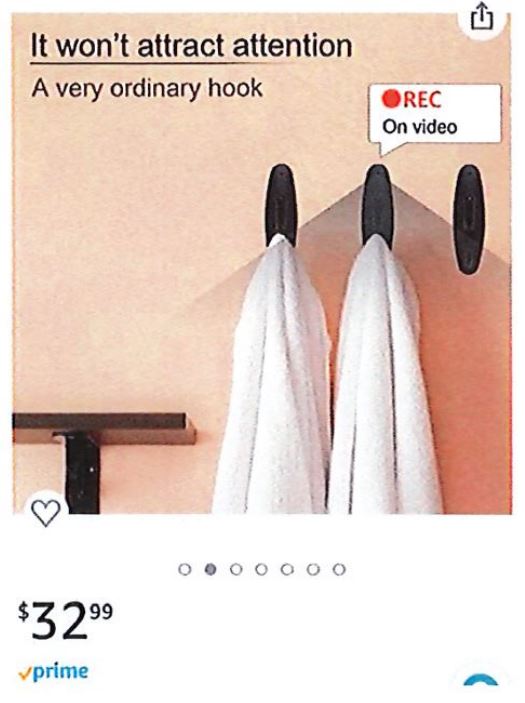Amazon May Be Liable for Merchant’s Spycam–M.S. v. Amazon
This case involves an “embedded pinhole camera” “disguised” as a “mountable hook” that a Doe merchant offered in Amazon’s Marketplace. Allegedly, Amazon inspected the item three times: Amazon’s Product Safety Team inspected it to confirm it couldn’t be used to violate sexual privacy; Amazon’s Dangerous Products Team inspected its lithium-ion battery; and the Fulfillment-by-Amazon team inspected it as well. After these inspections, Amazon approved the item for sale. Amazon also approved a product description that “shows the camera serving as a towel hook with the caption: ‘It won’t attract any attention[:] A very ordinary hook.'”
I believe the listing is still online. I easily found other similar “hook” cameras available on Amazon as well.
Wells allegedly bought the hook camera and used it to spy on a visiting foreign exchange student, who was a minor. The minor, M.S., sued Amazon. Most of the claims survive Amazon’s motion to dismiss.
Negligence
The court says that MS properly alleged negligence:
She alleges Amazon owed her a duty to not promote or distribute products that present a “foreseeable and unreasonable risk of harm to others.” She alleges that despite this duty, Amazon promoted, marketed, sold, and distributed John Doe’s camera. She alleges the camera alongside its product description “encourage[d] criminal conduct” and exposed others “to a foreseeable high risk of harm” when used to record individuals in sensitive locations—its “intended and marketed purpose.” When Wells used the camera “precisely as depicted on Amazon’s online retail store,” M.S. suffered emotional and physical harm.
These allegations raise a reasonable inference Amazon sold a camera knowing it would be used to record a third party in a bathroom without their consent
Duty. Amazon unsuccessfully pushed back on the duty issue:
Amazon failed to properly inspect John Doe’s camera three times—including an inspection by Amazon’s Product Safety team tasked with preventing the type of harm alleged here. Despite these inspections, Amazon approved the camera. Amazon then exercised control over the camera’s product description—including over the photographs encouraging using the camera in a private bathroom as a towel hook. Amazon then promoted the camera. Throughout all this, Amazon knew hidden cameras were used to spy on individuals in private spaces. Collectively, these allegations “permit the inference” Amazon knew its actions and omissions might expose others to a foreseeable high risk a third party would use the camera exactly as advertised—to surreptitiously record an individual in a private bathroom by using the camera as a towel hook.
The court cites other duty cases, including Maynard v. Snap, Lemmon v. Snap, In re Juul, and Braun v. Soldier of Fortune. The court summarizes: “when a seller promotes a product suggesting a particular use, harms that result from that suggested use are foreseeable.”
So, what steps could a hook camera merchant take to avoid creating this duty? I can’t tell if the court is reacting to the photo displaying the hook camera functioning as a towel hook or the words “it won’t attract attention.” If those words were deleted, would the court have ruled differently? Or is the very nature of a hook camera such that it always simultaneously creates and breaches the duty? (Note how such a standard is indistinguishable from strict liability). As confirmation that there may be no way around the court’s legal standard, the court doesn’t care if the ads promote legal uses of the hook camera: “It is immaterial whether the product description advertised several ‘legal uses.’ All advertised uses are foreseeable uses.”
Causation. Amazon also unsuccessfully pushed back on causation because Wells is an intervening tortfeasor. Basically repeating its duty analysis, the court extends causation back to Amazon:
Amazon approved and helped market John Doe’s camera. Amazon knew the camera’s product description suggested using the camera as a towel hook in the bathroom. Amazon cannot claim surprise when a consumer uses the camera that way…
Wells used the camera “precisely as depicted on Amazon’s online retail store.” This use was foreseeable.
Outrage Tort
Allegedly, “Amazon knew John Doe’s camera advertised an illegal use on its platform that was likely to cause harm yet did nothing to prevent it. This alleged conduct could reasonably be considered outrageous.” Amazon had sufficient intent to cause harm based on allegations that “Amazon ‘knew’ John Doe’s camera would ‘harm the subject of recording’ ‘when used as depicted on Amazon’s online retail store.’ In addition, she alleges Amazon acted with ‘reckless indifference’ when it ‘distributed’ John Doe’s camera after three rounds of inspection.”
The court also survives a civil conspiracy claim (really?) and rejects the RICO claim.
Implications
I know there can be good reasons why someone deploys an in-home surveillance camera, but I’m less clear on the appropriate use cases for a surreptitious hook camera. At the same time, the court’s analysis could indicate that all surreptitious hook cameras are categorically illegal to sell, even when buyers plan to use it completely legally. That makes this a dangerous ruling for the spycam industry and for Amazon. At the same time, I’m curious to hear more about what Amazon’s Product Safety team thought when it evaluated this item.
Case Citation: M.S. v. Amazon.com, Inc., 2023 WL 8283642 (S.D.W.V. Nov. 30, 2023)

Pingback: Judge: Amazon “cannot claim shock” that bathroom spycams were used as advertised | Ars Technica()
Pingback: Section 230 Helps Amazon Defeats False Advertising Lawsuit Over Printer Ink Cartridges-Planet Green v. Amazon - Technology & Marketing Law Blog()